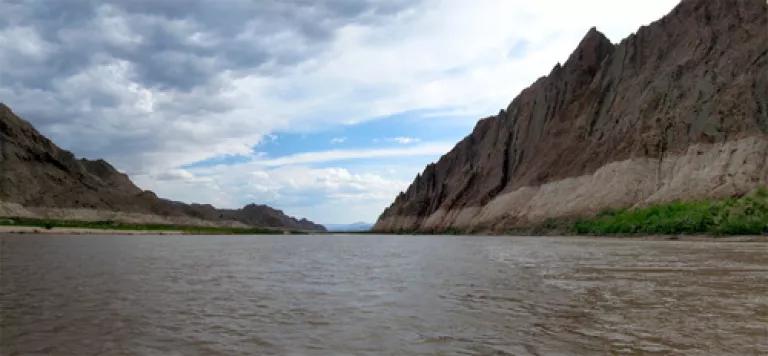Western Energy News Round-Up: Efficient Pool Pumps, Fracking Standards, Closing Coal Plants, and Climate Change Exacerbating Droughts and Wildfires

Western Energy News Round-Up is a weekly selection of news highlighting recent energy and environmental issues in the western United States.
August 8 – 14, 2013
Renewable Energy:
BLM approves new solar, geothermal development plan in Calif. Desert
The Obama administration has formally established a solar and geothermal power development area on a 64,000s acres of public and private land in Southern California. If fully developed, the area could power more than 1 million homes with renewable energy. BLM's plan calls for designating a 10,759-acre section of the West Chocolate Mountains Renewable Energy Evaluation Area (REEA). About 19,000 acres will be set aside for geothermal exploration and development. "We need to take a close look at these resources to determine where it makes sense to develop renewable energy and -- just as importantly -- where it does not," Interior Secretary Sally Jewell announced at the National Clean Energy Summit 6.0 this week. "As we double down on the unprecedented progress that the Obama administration has made on advancing clean energy, the Interior Department has an opportunity not only to cut carbon pollution, but also to advance important conservation goals."
(E&E, August 14, 2013)
Wind and solar energy complement each other in this daily production graph to produce essentially base load power. Credit: CEM. (California Energy Markets No. 1244, August 9, 2013)
There are almost 2 million residential pools and another 50,000 commercial pools in California. And approximately one out of every 10 Golden State residences has a spa or hot tub (over a million in total). Together these use a lot of energy. Fortunately, opportunities exist to reduce this energy use cost-effectively, saving consumers money while continuing to provide the same level of amenities. The California Energy Commission (CEC) is considering standards that would save Californians $105 million dollars and reduce electricity by 805 GWh annually, equivalent to the emissions from over 71,000 passenger vehicles.
(NRDC Switchboard Blog, August 12, 2013)
Fossil Fuels:
NTEC: How much will NN invest for possible $40 million gain?
The Navajo Nation Council is determining how much the tribe is willing to pay to preserve $40 million a year in royalties and taxes from the Four Corners Power Plant and Navajo Mine. The Navajo Nation had intended to purchase Navajo Mine from BHP Billiton New Mexico Coal Inc. by July 1. But Arizona Public Service Co.’s plans to acquire Southern California Edison’s share in Four Corners Power Plant have been delayed—and delayed BHP’s closing on the sale.
(Gallup Independent, August 14, 2013)
Lines drawn in San Juan debate
Public Service Company of New Mexico, environmentalists and renewable-energy advocates are gearing up for what could be an intense debate over the fuels that will replace coal-fired electricity at utility’s San Juan Generating Station. PNM struck an agreement in principle in February with the New Mexico Environment Department and the U.S. Environmental Protection Agency to shut down two of the coal plant’s four generating units to comply with federal haze regulations. The utility must make up for electricity that it will lose at San Juan. PNM executives say they want to replace the coal with a new, natural-gas generating plant at the same site, plus additional electricity from the Palo Verde Nuclear Generating Station in Arizona. But environmentalists and alternative-energy advocates say the company should seize the opportunity to move away from fossil fuels and add more wind- and solar-generated electricity.
(Albuquerque Journal, August 11, 2013)
Interior Wants to Use Carbon-Credit Scheme for Navajo Coal Emissions
The U.S. Department of the Interior agreed to adopt a new system for reducing carbon-dioxide emissions as part of a plan to decrease nitrogen-oxide pollution from the Navajo Generating Station in Arizona. Under the scheme, which the Environmental Protection Agency must approve, Interior could purchase renewable energy, make efficiency improvements, or invest in a solar facility outside Nevada that would offset emissions. (NRDC was not a party to this agreement.)
(California Energy Markets No. 1244, August 9, 2013)
Utilities:
Some large coal power plants are getting life extensions
Some utilities are making substantial investments to keep their largest coal generating stations operating for decades — and emitting millions of tons of carbon dioxide annually. Many utilities are shutting down small, older coal-fired units, but upgrades are planned or underway at more than 100 Midwestern coal power plants to reduce emissions of mercury or other air pollutants. These may not be the best investments for their customers, as the Obama administration is obligated, and promises, to regulate greenhouse gas emissions in 2015. “Those standards are not going to shut down every coal plant in the United States,” said Daniel Lashof, director of climate and clean air programs for the Natural Resources Defense Council. Greenhouse gas regulation likely will focus on energy conservation and expanding clean sources like wind power — strategies already employed in Minnesota, Lashof said. (Note: NRDC supports state emissions performance standards rules that protect customers from these sorts of potentially stranded investments.)
(Star Tribune, August 14, 2013)
Editorial: Oregon and the Northwest need a working BPA that's run from here
The Oregonian argues that the Bonneville Power Administration is the most significant public agency in the Pacific Northwest: Federal investigators found that BPA managers misapplied hiring rules, placing military veterans at a disadvantage, and threatened on-staff whistleblowers. The findings triggered a crackdown unseen in the agency's history. But the Northwest needs a working BPA soon, not later. The federal review needs to be succinct and a leadership team installed at BPA so that the agency, short-leashed by DOE, can meet the Northwest's burgeoning power needs.
(The Oregonian, August 7, 2013)
Letter to the Editor: Ron Binz Was Wise and Efficient in Serving Colorado
Several former commissioners of the Federal Energy Regulatory Commission object to the Wall Street Journal’s July 30 editorial "Ron Binz's Rules for Radicals" criticizing Ron Binz, the president's nominee to chair the FERC, and implying that the FERC is pursuing an agenda unconstrained by law or national policy. The former commissioners argue that Mr. Binz has an impressive 34-year career in energy policy. The bipartisan group says that if the Senate confirms him, he will be a fair and impartial judge and further the public interest within the FERC's authority. NRDC also supports the nomination of Ron Binz to chair the FERC.
(Wall Street Journal, August 8, 2013)
Warren Buffett could soon own the largest energy holding company in the U.S.
Billionaire investor Warren Buffett sees dollar signs in Nevada. Buffett's Berkshire Hathaway has made a $10 billion offer to acquire NV Energy, Inc., a deal that would create what has been called the largest utility holding company in the U.S. The acquisition, through Berkshire Hathaway subsidiary MidAmerican Energy Holdings, is expected to be completed in early 2014. NV Energy has two main subsidiaries, Nevada Power Company and Sierra Pacific Power Company, both of which operate under the NV brand name. Nevada Senator Harry Reid, the Senate Majority Leader, sent a letter to the Federal Energy Regulation Commission last month saying the acquisition would be good for the state's economy while providing more green energy sources.
(Mother Nature Network, August 8, 2013)
Climate Change:

Lake Mead’s “bathtub ring” at the top of the white band shows how high the water used to be. (Photo by Alan Stark, under Creative Commons licensing.)
How Two Reservoirs Have Become Billboards For What Climate Change Is Doing To The American West
To see how climate change will pull a nasty water surprise on the desert Southwest, you only need to look at one river. The Colorado River basically makes modern life possible in seven western states by providing water for some 40 million people and irrigating 4 million acres of crops. It is also depended upon by 22 native American tribes, 7 national wildlife refuges and 11 national parks. Lake Powell, and its downstream cousin, Lake Mead are the two largest reservoirs in the U.S, but Persistent drought, and diminished snow runoff in the Rocky Mountains, have drastically shrunk the two reservoirs. Both are now less than half full. Inflows to Powell this year are about 42 percent of average. See here for the high costs of extreme drought caused by climate change.
(Climate Progress, August 12, 2013)
Southern California wildfire grows to 27 square miles
Firefighters launched a fleet of seven retardant-dropping airplanes against Southern California's latest destructive wildfire on Friday. The blaze has destroyed 26 homes and threatened more than 500 others in the San Jacinto Mountains. So far this year, California fire officials have battled 4,300 wildfires, a stark increase from the yearly average of nearly 3,000 they faced from 2008 to 2012. It's still weeks before the fire-fanning Santa Ana winds usually arrive in Southern California. After touring the area, U.S. Sen. Barbara Boxer, D-Calif., who lives in Riverside County, said 165,000 acres have burned in California this year. Unless we take action, things are only going to get worse, she said. Wildfires also take a significant toll on public health.
(Fox News, August 10, 2013)
Conservation:
Agencies release plan for evaluating western energy corridors
The Bureau of Land Management and forest service are re-evaluating where transmission lines should go in the west to lessen their impacts and help renewables. Like guiding wind and solar projects to low-conflict areas, finding the right places for transmission lines is a common sense approach. Federal agencies plan to make recommendations for improving the “West-wide Energy Corridors” by the summer of 2014. This summer the agencies published an agreement that details how they will complete their first re-evaluation of the corridors.
(Wilderness Society, August 8, 2013)
Officers release beavers rehabilitated after Chevron spill
Utah’s famous Willard Bay beavers got a new home and a happy send-off Tuesday after nearly five months of living in an Ogden wildlife rehabilitation center. Wildlife officials rescued the beavers at Willard Bay State Park in March after a Chevron Pipe Line Co. pipe ruptured and spewed more than 20,000 gallons of diesel fuel into a wetland just east of Willard Bay Reservoir. A series of dams the beavers had built helped contain the spill and keep it out of the reservoir. This pipeline spill is hardly unique unfortunately, as was documented in Arkansas in March and as is expected from the Keystone XL pipeline should it be approved.
(Salt Lake Tribune, August 13, 2013)
Compiled by Meredith Connolly
